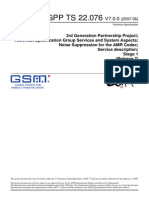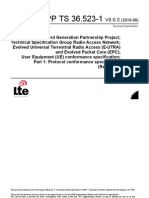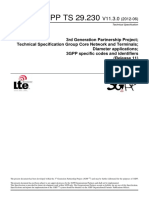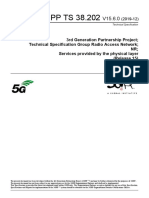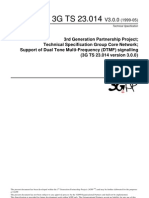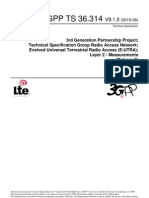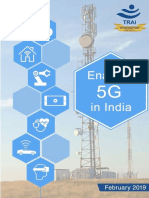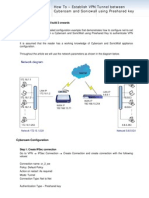36214-870 Lte
36214-870 Lte
Uploaded by
Punita SharmaCopyright:
Available Formats
36214-870 Lte
36214-870 Lte
Uploaded by
Punita SharmaOriginal Title
Copyright
Available Formats
Share this document
Did you find this document useful?
Is this content inappropriate?
Copyright:
Available Formats
36214-870 Lte
36214-870 Lte
Uploaded by
Punita SharmaCopyright:
Available Formats
3GPP TS 36.214 V8.7.
0 (2009-09)
Technical Specification
3rd Generation Partnership Project; Technical Specification Group Radio Access Network; Evolved Universal Terrestrial Radio Access (E-UTRA); Physical layer Measurements (Release 8)
The present document has been developed within the 3rd Generation Partnership Project (3GPP TM) and may be further elaborated for the purposes of 3GPP. The present document has not been subject to any approval process by the 3GPP Organizational Partners and shall not be implemented. This Specification is provided for future development work within 3GPP only. The Organizational Partners accept no liability for any use of this Specification. Specifications and reports for implementation of the 3GPP TM system should be obtained via the 3GPP Organizational Partners Publications Offices.
Release 8
3GPP TS 36.214 V8.7.0 (2009-09)
Keywords
UMTS, radio, layer 1
3GPP Postal address
3GPP support office address
650 Route des Lucioles Sophia Antipolis Valbonne Franc e Tel. : +33 4 92 94 42 00 Fax : +33 4 93 65 47 16
Internet
http ://www.3gpp.org
Copyright Notification No part may be reproduced except as authorized by written permission. The copyright and the foregoing restriction extend to reproduction in all media.
2009, 3GPP Organizational Partners (ARIB, ATIS, CCSA, ETSI, TTA, TTC). All rights reserved. UMTS is a Trade Mark of ETSI registered for the benefit of its members 3GPP is a Trade Mark of ETSI registered for the benefit of its Members and of the 3GPP Organizational Partners LTE is a Trade Mark of ETSI currently being registered for the benefit of its Members and of the 3GPP Organizational Partners GSM and the GSM logo are registered and owned by the GSM Association
3GPP
Release 8
3GPP TS 36.214 V8.7.0 (2009-09)
Contents
Foreword ............................................................................................................................................................4 1 2 3
3.1 3.2 3.3
Scope ........................................................................................................................................................5 References ................................................................................................................................................5 Definitions, symbols and abbreviations ...................................................................................................5
Definitions............................................................................................................................................................. 5 Symbols ................................................................................................................................................................. 6 Abbreviations ........................................................................................................................................................ 6
4 5
5.1 5.1.1 5.1.2 5.1.3 5.1.4 5.1.5 5.1.6 5.1.7 5.1.8 5.1.9 5.1.10 5.1.11 5.2 5.2.1 5.2.2 5.2.3
Control of UE/E-UTRAN measurements.................................................................................................6 Measurement capabilities for E-UTRA....................................................................................................6
UE measurement capabilities................................................................................................................................ 7 Reference Signal Received Power (RSRP) .................................................................................................... 7 Void ................................................................................................................................................................. 7 Reference Signal Received Quality (RSRQ)................................................................................................. 8 UTRA FDD CPICH RSCP ............................................................................................................................. 8 UTRA FDD carrier RSSI ................................................................................................................................ 8 UTRA FDD CPICH Ec/No............................................................................................................................. 9 GSM carrier RSSI ........................................................................................................................................... 9 UTRA TDD carrier RSSI................................................................................................................................ 9 UTRA TDD P-CCPCH RSCP ........................................................................................................................ 9 CDMA2000 1x RTT Pilot Strength................................................................................................................ 9 CDMA2000 HRPD Pilot Strength................................................................................................................ 10 E-UTRAN measurement abilities....................................................................................................................... 10 DL RS TX power .......................................................................................................................................... 10 Received Interference Power ........................................................................................................................ 11 Thermal noise power..................................................................................................................................... 11
Annex A (informative):
Change history ...............................................................................................12
3GPP
Release 8
3GPP TS 36.214 V8.7.0 (2009-09)
Foreword
This Technical Specification has been produced by the 3rd Generation Partnership Project (3GPP). The contents of the present document are subject to continuing work within the TSG and may change following formal TSG approval. Should the TSG modify the contents of the present document, it will be re-released by the TSG with an identifying change of release date and an increase in version number as follows: Version x.y.z where: x the first digit: 1 presented to TSG for information; 2 presented to TSG for approval; 3 or greater indicates TSG approved document under change control. Y the second digit is incremented for all changes of substance, i.e. technical enhancements, corrections, updates, etc. z the third digit is incremented when editorial only changes have been incorporated in the document.
3GPP
Release 8
3GPP TS 36.214 V8.7.0 (2009-09)
Scope
The present document contains the description and definition of the measurements done at the UE and network in order to support operation in idle mode and connected mode.
References
References are either specific (identified by date of publication, edition number, version number, etc.) or non-specific. For a specific reference, subsequent revisions do not apply. For a non-specific reference, the latest version applies. In the case of a reference to a 3GPP document (including a GSM document), a non-specific reference implicitly refers to the latest version of that document in the same Release as the present document. [1] [2] [3] [4] [5] [6] [7] [8] [9] [10] 3GPP TR 21.905: Vocabulary for 3GPP Specifications. 3GPP TS 36.201: Evolved Universal Terrestrial Radio Access (E-UTRA); Physical Layer General Description . 3GPP TS 36.211: Evolved Universal Terrestrial Radio Access (E-UTRA); Physical channels and modulation. 3GPP TS 36.212: Evolved Universal Terrestrial Radio Access (E-UTRA); Multiplexing and channel coding . 3GPP TS 36.213: Evolved Universal Terrestrial Radio Access (E-UTRA); Physical layer procedures . 3GPP TS 36.321: Evolved Universal Terrestrial Radio Access (E-UTRA); Medium Access Control (MAC) protocol specification. 3GPP TS 36.331: Evolved Universal Terrestrial Radio Access (E-UTRA); Radio Resource Control (RRC); Protocol specification . 3GPP2 CS.0005-D v1.0 Upper Layer (Layer 3) Signaling Standard for CDMA2000 Spread Spectrum Systems Release D. 3GPP2 CS.0024-A v3.0 cdma2000 High Rate Packet Data Air Interface Specification 3GPP TS 36.104: Evolved Universal Terrestrial Radio Access (E-UTRA); Base Station (BS) radio transmission and reception .
The following documents contain provisions which, through reference in this text, constitute provisions of the present document.
3
3.1
Definitions, symbols and abbreviations
Definitions
For the purposes of the present document, the terms and definitions given in TR 21.905 [1] and the following apply. A term defined in the present document takes precedence over the definition of the same term, if any, in TR 21.905 [1].
3GPP
Release 8
3GPP TS 36.214 V8.7.0 (2009-09)
3.2
Ec/No
Symbols
Received energy per chip divided by the power density in the band
For the purposes of the present document, the following symbols apply:
3.3
Abbreviations
For the purposes of the present document, the abbreviations given in TR 21.905 [1] and the following apply. An abbreviation defined in the present document takes precedence over the definition of the same abbreviation, if any, in TR 21.905 [1]. 1x RTT CPICH E-UTRA E-UTRAN FDD GSM HRPD P-CCPCH RSCP RSRP RSRQ RSSI TDD UTRA UTRAN CDMA2000 1x Radio Transmission Technology Common Pilot Channel Evolved UTRA Evolved UTRAN Frequency Division Duplex Global System for Mobile communication CDMA2000 High Rate Packet Data Primary Common Control Physical Channel Received Signal Code Power Reference Signal Received Power Reference Signal Received Quality Received Signal Strength Indicator Time Division Duplex Universal Terrestrial Radio Access Universal Terrestrial Radio Access Network
Control of UE/E-UTRAN measurements
In this chapter the general measurement control concept of the higher layers is briefly described to provide an understanding on how L1 measurements are initiated and controlled by higher layers. With the measurement specifications L1 provides measurement capabilities for the UE and E-UTRAN. These measurements can be classified in different reported measurement types: intra-frequency, inter-frequency, inter-system, traffic volume, quality and UE internal measurements (see the RRC Protocol [7]). In the L1 measurement definitions, see chapter 5, the measurements are categorised as measurements in the UE (the messages for these will be described in the MAC Protocol [6] or RRC Protocol [7]) or measurements in the E-UTRAN (the messages for these will be described in the Frame Protocol). To initiate a specific measurement, the E-UTRAN transmits a RRC connection reconfiguration message' to the UE including a measurement ID and type, a command (setup, modify, release), the measurement objects, the measurement quantity, the reporting quantities and the reporting criteria (periodical/event-triggered), see [7]. When the reporting criteria are fulfilled the UE shall answer with a 'measurement report message' to the E-UTRAN including the measurement ID and the results. For idle mode, the measurement information elements are broadcast in the System Information.
Measurement capabilities for E-UTRA
In this chapter the physical layer measurements reported to higher layers are defined.
3GPP
Release 8
3GPP TS 36.214 V8.7.0 (2009-09)
5.1
UE measurement capabilities
The structure of the table defining a UE measurement quantity is shown below.
Column field Definition Applicable for
Comment Contains the definition of the measurement. States in which state(s) it shall be possible to perform this measurement. The following terms are used in the tables: RRC_IDLE; RRC_CONNECTED; Intra-frequency appended to the RRC state: Shall be possible to perform in the corresponding RRC state on an intra-frequency cell; Inter-frequency appended to the RRC state: Shall be possible to perform in the corresponding RRC state on an inter-frequency cell Inter-RAT appended to the RRC state: Shall be possible to perform in the corresponding RRC state on an inter-RAT cell.
5.1.1
Reference Signal Received Power (RSRP)
Definition
Reference signal received power (RSRP), is defined as the linear average over the power contributions (in [W]) of the resource elements that carry cell-specific reference signals within the considered measurement frequency bandwidth. For RSRP determination the cell-specific reference signals R0 according TS 36.211 [3] shall be used. If the UE can reliably detect that R1 is available it may use R1 in addition to R0 to determine RSRP. The reference point for the RSRP shall be the antenna connector of the UE. If receiver diversity is in use by the UE, the reported value shall not be lower than the corresponding RSRP of any of the individual diversity branches. RRC_IDLE intra-frequency, RRC_IDLE inter-frequency, RRC_CONNECTED intra-frequency, RRC_CONNECTED inter-frequency
Applicable for
Note1: The number of resource elements within the considered measurement frequency bandwidth and within the measurement period that are used by the UE to determine RSRP is left up to the UE implementation with the limitation that corresponding measurement accuracy requirements have to be fulfilled. Note 2: The power per resource element is determined from the energy received during the useful part of the symbol, excluding the CP.
5.1.2
Void
3GPP
Release 8
3GPP TS 36.214 V8.7.0 (2009-09)
5.1.3
Reference Signal Received Quality (RSRQ)
Definition
Reference Signal Received Quality (RSRQ) is defined as the ratio NRSRP/(E-UTRA carrier RSSI), where N is the number of RBs of the E-UTRA carrier RSSI measurement bandwidth. The measurements in the numerator and denominator shall be made over the same set of resource blocks. E-UTRA Carrier Received Signal Strength Indicator (RSSI), comprises the linear average of the total received power (in [W]) observed only in OFDM symbols containing reference symbols for antenna port 0, in the measurement bandwidth, over N number of resource blocks by the UE from all sources, including co-channel serving and non-serving cells, adjacent channel interference, thermal noise etc. The reference point for the RSRQ shall be the antenna connector of the UE. If receiver diversity is in use by the UE, the reported value shall not be lower than the corresponding RSRQ of any of the individual diversity branches. RRC_CONNECTED intra-frequency, RRC_CONNECTED inter-frequency
Applicable for
5.1.4
UTRA FDD CPICH RSCP
Definition
Applicable for
Received Signal Code Power, the received power on one code measured on the Primary CPICH. The reference point for the RSCP shall be the antenna connector of the UE. If Tx diversity is applied on the Primary CPICH the received code power from each antenna shall be separately measured and summed together in [W] to a total received code power on the Primary CPICH. If receiver diversity is in use by the UE, the reported value shall not be lower than the corresponding CPICH RSCP of any of the individual receive antenna branches. RRC_IDLE inter-RAT, RRC_CONNECTED inter-RAT
5.1.5
UTRA FDD carrier RSSI
Definition
Applicable for
The received wide band power, including thermal noise and noise generated in the receiver, within the bandwidth defined by the receiver pulse shaping filter. The reference point for the measurement shall be the antenna connector of the UE. If receiver diversity is in use by the UE, the reported value shall not be lower than the corresponding UTRA carrier RSSI of any of the individual receive antenna branches. RRC_IDLE inter-RAT, RRC_CONNECTED inter-RAT
3GPP
Release 8
3GPP TS 36.214 V8.7.0 (2009-09)
5.1.6
UTRA FDD CPICH Ec/No
Definition
Applicable for
The received energy per chip divided by the power density in the band. If receiver diversity is not in use by the UE, the CPICH Ec/No is identical to CPICH RSCP/UTRA Carrier RSSI. Measurement shall be performed on the Primary CPICH. The reference point for the CPICH Ec/No shall be the antenna connector of the UE. If Tx diversity is applied on the Primary CPICH the received energy per chip (Ec) from each antenna shall be separately measured and summed together in [Ws] to a total received chip energy per chip on the Primary CPICH, before calculating the Ec/No. If receiver diversity is in use by the UE, the measured CPICH Ec/No value shall not be lower than the corresponding CPICH RSCPi/UTRA Carrier RSSIi of receive antenna branch i . RRC_IDLE inter-RAT, RRC_CONNECTED inter-RAT
5.1.7
GSM carrier RSSI
Definition
Applicable for
Received Signal Strength Indicator, the wide-band received power within the relevant channel bandwidth. Measurement shall be performed on a GSM BCCH carrier. The reference point for the RSSI shall be the antenna connector of the UE. RRC_IDLE inter-RAT, RRC_CONNECTED inter-RAT
5.1.8
UTRA TDD carrier RSSI
Definition
Applicable for
The received wide band power, including thermal noise and noise generated in the receiver, within the bandwidth defined by the receiver pulse shaping filter, for TDD within a specified timeslot. The reference point for the measurement shall be the antenna connector of the UE. RRC_IDLE inter-RAT, RRC_CONNECTED inter-RAT
5.1.9
UTRA TDD P-CCPCH RSCP
Definition Applicable for
Received Signal Code Power, the received power on P-CCPCH of a neighbour UTRA TDD cell. The reference point for the RSCP shall be the antenna connector of the UE. RRC_IDLE inter-RAT, RRC_CONNECTED inter-RAT
5.1.10
CDMA2000 1x RTT Pilot Strength
Definition Applicable for
CDMA2000 1x RTT Pilot Strength measurement is defined in section 2.6.6.2.2 of [8] RRC_IDLE inter-RAT, RRC_CONNECTED inter-RAT
3GPP
Release 8
10
3GPP TS 36.214 V8.7.0 (2009-09)
5.1.11
CDMA2000 HRPD Pilot Strength
Definition Applicable for
CDMA2000 HRPD Pilot Strength Measurement is defined in section 8.7.6.1.2.3 of [9] RRC_IDLE inter-RAT, RRC_CONNECTED inter-RAT
5.2
E-UTRAN measurement abilities
The structure of the table defining a E-UTRAN measurement quantity is shown below.
Column field Definition
Comment Contains the definition of the measurement.
The term "antenna connector" used in this sub-clause to define the reference point for the E-UTRAN measurements refers to the "BS antenna connector" test port A and test port B as described in [10]. The term "antenna connector" refers to Rx or Tx antenna connector as described in the respective measurement definitions.
5.2.1
DL RS TX power
Definition
Downlink reference signal transmit power is determined for a considered cell as the linear average over the power contributions (in [W]) of the resource elements that carry cell-specific reference signals which are transmitted by the eNode B within its operating system bandwidth. For DL RS TX power determination the cell-specific reference signals R0 and if available R1 according TS 36.211 [3] can be used. The reference point for the DL RS TX power measurement shall be the TX antenna connector.
3GPP
Release 8
11
3GPP TS 36.214 V8.7.0 (2009-09)
5.2.2
Received Interference Power
Definition
The uplink received interference power, including thermal noise, within one physical resource blocks bandwidth of N sc resource elements as defined in TS 36.211 [3]. The reported value shall contain a set of Received Interference Powers of physical resource blocks
RB
n PRB = 0,..., N UL RB 1 as defined in TS 36.211 [3]. The reference point for the measurement shall
be the RX antenna connector. In case of receiver diversity, the reported value shall be linear average of the power in the diversity branches.
5.2.3
Thermal noise power
Definition
The uplink thermal noise power within the UL system bandwidth consisting of N RB resource blocks as defined in [3]. It is defined as (No x W), where No denotes the white noise power spectral density on the uplink carrier frequency and W = N RB N sc f denotes the UL system bandwidth. The measurement is optionally reported together with the Received Interference Power measurement, it shall be determined over the same time period as the Received Interference Power measurement, The reference point for the measurement shall be the RX antenna connector. In case of receiver diversity, the reported value shall be linear average of the power in the diversity branches.
UL RB
UL
3GPP
Release 8
12
3GPP TS 36.214 V8.7.0 (2009-09)
Annex A (informative): Change history
Change history
Date TSG # 02/10/06 11/10/06 13/10/06 27/02/07 05/03/07 03/05/07 08/03/07 31/05/07 RAN#36 21/06/07 25/06/07 17/08/07 20/08/07 10/09/07 RAN#37 12/09/07 RAN_37 28/11/07 RAN_38 05/03/08 RAN_39 28/05/08 RAN_40 28/05/08 09/09/08 09/09/08 03/12/08 04/03/09 15/09/09 CR Rev Subject/Comment Draft version created Minor editorial updates for RAN1#46bis Endorsed skeleton Update after 3GPP TSG RAN WG1 #48 RAN1 endorsed version Update after 3GPP TSG RAN WG1#48bis RAN WG1#49 endorsed version Presented for information at RAN#36 Update after 3GPP TSG RAN #36 3GPP TSG RAN WG1#49bis endorsed version Update after 3GPP TSG RAN WG1#48bis 3GPP TSG RAN WG1#50 endorsed version For approval at RAN#37 - Approved version 0001 1 RRC state correction for LTE UE measurements 0003 1 Inclusion of agreements from RAN1#51bis and RAN1#52 0004 - Introduction of eNode B Measurement of Received Interference Power RAN_40 RP-080435 0005 - Introduction of eNode B Measurement of Thermal Noise Power RAN_41 RP-080671 0006 - Modification to the RSRP definition RAN_41 RP-080671 0007 RAN_42 RP-080985 0008 RAN_43 RP-090237 0009 RAN_45 RP-090888 0010 TSG Doc. RP-070490 RP-070732 RP-070732 RP-070949 RP-080145 RP-080435 Old 0.0.0 0.0.1 0.1.0 0.1.1 0.2.0 0.2.1 0.3.0 1.0.0 1.0.1 1.1.0 1.1.1 1.2.0 2.0.0 8.0.0 8.1.0 8.2.0 8.2.0 8.3.0 8.3.0 8.4.0 8.5.0 8.6.0 New 0.0.0 0.0.1 0.1.0 0.1.1 0.2.0 0.2.1 0.3.0 1.0.0 1.0.1 1.1.0 1.1.1 1.2.0 2.0.0 8.0.0 8.1.0 8.2.0 8.3.0 8.3.0 8.4.0 8.4.0 8.5.0 8.6.0 8.7.0
Modification of RSRQ definition and removal of RSSI RSRQ Measurement Definition RSRP and RSRQ Definitions with Receiver Diversity Clarification on reference point of RSRP and RSRQ for EUTRA
3GPP
You might also like
- 3GPP TR 23.870Document14 pages3GPP TR 23.870santanameroNo ratings yet
- 920Document26 pages920Amit Baran ChatterjeeNo ratings yet
- A90Document50 pagesA90srmanoharaNo ratings yet
- Call Waiting and Call HoldDocument16 pagesCall Waiting and Call HoldankitlohiaNo ratings yet
- 3GPP TS 29.230 V10.4.0 (2011-09)Document30 pages3GPP TS 29.230 V10.4.0 (2011-09)Đorđe HirschNo ratings yet
- 3GPP TS 22.090Document10 pages3GPP TS 22.090santanameroNo ratings yet
- 3GPP Document For ChannelsDocument12 pages3GPP Document For ChannelsSantosh GuptaNo ratings yet
- 51 - 010 - Mobile Station (MS) Conformance Specification PDFDocument110 pages51 - 010 - Mobile Station (MS) Conformance Specification PDFTan PhamNo ratings yet
- 800Document18 pages800adilsonpiuNo ratings yet
- b60Document34 pagesb60srmanoharaNo ratings yet
- 3GPP TR 36.913: Technical ReportDocument15 pages3GPP TR 36.913: Technical Report문상미No ratings yet
- 3GPP TR 21.801Document5 pages3GPP TR 21.801santanameroNo ratings yet
- 3GPP TS 21.101Document17 pages3GPP TS 21.101santanameroNo ratings yet
- 3GPP TS 29.230Document27 pages3GPP TS 29.230Dana AlhalabiNo ratings yet
- 920Document29 pages920Urvin ShahNo ratings yet
- 3GPP TS 22.076Document10 pages3GPP TS 22.076santanameroNo ratings yet
- 3GPP TS 36.414 - EUTRAN - S1 Data TransportDocument8 pages3GPP TS 36.414 - EUTRAN - S1 Data TransportfeisaliliasNo ratings yet
- 3GPP TR 23.919Document11 pages3GPP TR 23.919Koubi BataNo ratings yet
- 3GPP TS 23.088Document34 pages3GPP TS 23.088santanameroNo ratings yet
- 23919-900 Direct Tunnel Deployment GuidelineDocument11 pages23919-900 Direct Tunnel Deployment GuidelinemakismakNo ratings yet
- 3GPP TS 24.002Document11 pages3GPP TS 24.002qwxdqwdxwqNo ratings yet
- 3GPP TS 22.096Document10 pages3GPP TS 22.096santanameroNo ratings yet
- 3GPP TS 21.101Document15 pages3GPP TS 21.101EftalitNo ratings yet
- 3GPP TS 32.450Document16 pages3GPP TS 32.450Олег ДрошневNo ratings yet
- Release 13 TR 21.905 V13.0.0 Vocabulary For 3GPP SpecificationsDocument65 pagesRelease 13 TR 21.905 V13.0.0 Vocabulary For 3GPP SpecificationsFlávia LarisseNo ratings yet
- 3GPP TS 36.523-1: Technical SpecificationDocument36 pages3GPP TS 36.523-1: Technical SpecificationAlisa TsaiNo ratings yet
- Cmas 3GPP SpecDocument13 pagesCmas 3GPP SpecGodisgreateNo ratings yet
- 3GPP TS 22.076Document10 pages3GPP TS 22.076santanameroNo ratings yet
- 3GPP TS 22.076Document10 pages3GPP TS 22.076santanameroNo ratings yet
- 36201-c20 4G LTE Physical Layer General DescriptionDocument15 pages36201-c20 4G LTE Physical Layer General DescriptionDuval FortesNo ratings yet
- 3GPP TS 23.401: Technical SpecificationDocument238 pages3GPP TS 23.401: Technical SpecificationSuhelSiddiquiNo ratings yet
- 3GPP TS 29.230Document30 pages3GPP TS 29.230Reeve TanNo ratings yet
- 620 IuantDocument11 pages620 IuantABHILASHNo ratings yet
- 3GPP TS 22.142Document12 pages3GPP TS 22.142santanameroNo ratings yet
- 3GPP TS 48.058: Technical SpecificationDocument84 pages3GPP TS 48.058: Technical Specificationscropio_indianNo ratings yet
- 32435-900 XML 3GPP PDFDocument16 pages32435-900 XML 3GPP PDFRusdiantoMahmudNo ratings yet
- 21905-h10 - Vocabulary For 3GPP SpecificationsDocument65 pages21905-h10 - Vocabulary For 3GPP Specificationsbinayaks248No ratings yet
- 3GPP TS 22.002Document13 pages3GPP TS 22.002Ahmad Mustafa AtharNo ratings yet
- 3GPP TS 29.272: Technical SpecificationDocument57 pages3GPP TS 29.272: Technical SpecificationjbarriospNo ratings yet
- 3GPP TS 24.081Document12 pages3GPP TS 24.081santanameroNo ratings yet
- 25424-630-Iur DataDocument10 pages25424-630-Iur DataABHILASHNo ratings yet
- 3GPP TS 25.211Document58 pages3GPP TS 25.211Vivek KumarNo ratings yet
- 3GPP TS 38.202Document14 pages3GPP TS 38.202jinNo ratings yet
- 3GPP TS 24.085Document10 pages3GPP TS 24.085santanameroNo ratings yet
- 3gpp27103 500Document11 pages3gpp27103 500mzyptNo ratings yet
- 3GPP TS 24.081Document12 pages3GPP TS 24.081santanameroNo ratings yet
- RANAPDocument394 pagesRANAPJogendra SinghNo ratings yet
- 3GPP TS 22.076Document10 pages3GPP TS 22.076santanameroNo ratings yet
- JP-3GA-27.003 (R99) Terminal Adaptation Functions (TAF) For Services Using Synchronous Bearer CapabilitiesDocument27 pagesJP-3GA-27.003 (R99) Terminal Adaptation Functions (TAF) For Services Using Synchronous Bearer Capabilitiesatul_potdarNo ratings yet
- 3GPP TS 38.533Document10 pages3GPP TS 38.533AhmedMa'moonNo ratings yet
- 21905-d00 Vocabulary For 3GPP SpecificationsDocument65 pages21905-d00 Vocabulary For 3GPP Specificationsحمودي حموديNo ratings yet
- 3GPP TS 25.306Document50 pages3GPP TS 25.306Johnny DoeNo ratings yet
- DTMF Signalling in 3gDocument10 pagesDTMF Signalling in 3gFaheem AkhtarNo ratings yet
- ARIB STD-T63-25.432 V3.1.0 UTRAN Lub Interface: Signalling Transport (Release 1999)Document9 pagesARIB STD-T63-25.432 V3.1.0 UTRAN Lub Interface: Signalling Transport (Release 1999)samarjanaNo ratings yet
- 800Document27 pages800santanameroNo ratings yet
- 3GPP TS 25.461Document15 pages3GPP TS 25.461subha109No ratings yet
- Evolved Universal Terrestrial Radio Access (E-UTRA) Physical Layer For Relaying OperationDocument16 pagesEvolved Universal Terrestrial Radio Access (E-UTRA) Physical Layer For Relaying OperationJennifer HaneyNo ratings yet
- 3GPP TR 23.039: Technical SpecificationDocument7 pages3GPP TR 23.039: Technical SpecificationsantanameroNo ratings yet
- 3GPP TS 36.314Document17 pages3GPP TS 36.314Adela VladNo ratings yet
- 01-HUAWEI DSLAM Pre-Sales Specialist Training V1.0Document43 pages01-HUAWEI DSLAM Pre-Sales Specialist Training V1.0rechtacekNo ratings yet
- Digital CommunicationDocument43 pagesDigital CommunicationRavi kumarNo ratings yet
- 5G WTTX Planning V1 2Document41 pages5G WTTX Planning V1 2ashishsinghchouhan100% (1)
- Yeastar S-Series DatasheetDocument2 pagesYeastar S-Series Datasheetnmc79No ratings yet
- 5.2.2.6 Lab - Configuring SNMPDocument12 pages5.2.2.6 Lab - Configuring SNMPHenri KelderNo ratings yet
- The Leading Innovator in Global Cloud Networking: NOC Training T1/T3. Presented by Dennis GoddardDocument40 pagesThe Leading Innovator in Global Cloud Networking: NOC Training T1/T3. Presented by Dennis GoddardsachindjjNo ratings yet
- Hicom Office 150E v2.2 Service ManualDocument1,234 pagesHicom Office 150E v2.2 Service Manualvenci_kamenov100% (1)
- Difference Between Circuit Switching and Packet SwitchingDocument5 pagesDifference Between Circuit Switching and Packet SwitchingMUHAMMAD AFAQ NISARNo ratings yet
- Information TechnologyDocument128 pagesInformation TechnologySatyam Maram50% (2)
- White Paper 22022019 PDFDocument79 pagesWhite Paper 22022019 PDFKunal KhandelwalNo ratings yet
- MPLS ConceptsDocument30 pagesMPLS Conceptssyztemlabs100% (37)
- 24 How To - Establish VPN Tunnel Between Cyberoam and Sonicwall Using Preshared KeyDocument4 pages24 How To - Establish VPN Tunnel Between Cyberoam and Sonicwall Using Preshared KeySirish BabuNo ratings yet
- Telecommunication Industrial SkillsDocument15 pagesTelecommunication Industrial SkillsAditya KapoorNo ratings yet
- OTU Transmissions 2009Document33 pagesOTU Transmissions 2009Andrey IonutNo ratings yet
- 1gto5g 140404083638 Phpapp01Document26 pages1gto5g 140404083638 Phpapp01Anuj SanathananNo ratings yet
- The New Packet Scheduling Algorithms For VOQ Switches: (Anna - Baranowska, Wojciech - Kabacinski) @et - Put.poznan - PLDocument6 pagesThe New Packet Scheduling Algorithms For VOQ Switches: (Anna - Baranowska, Wojciech - Kabacinski) @et - Put.poznan - PLmfhfhfNo ratings yet
- Iv. Telephone Receiver Is Device That Converts Electrical Energy Into Sound Energy. True/ FalseDocument3 pagesIv. Telephone Receiver Is Device That Converts Electrical Energy Into Sound Energy. True/ FalseAdnan ShaukatNo ratings yet
- Physical Layer: Schedule: MW 1:30 PM - 2:45 PM, Tahoe Hall 1026 Instructor: Dr. Sadaf AshtariDocument26 pagesPhysical Layer: Schedule: MW 1:30 PM - 2:45 PM, Tahoe Hall 1026 Instructor: Dr. Sadaf AshtariThông LạiNo ratings yet
- Lesson Plan 6.15Document7 pagesLesson Plan 6.15Rhame NalcoNo ratings yet
- 11-8 Serial Communication: Difference Between andDocument8 pages11-8 Serial Communication: Difference Between andsubramanyam62No ratings yet
- Arris: BSR 64000 (Broadband Services Router)Document3 pagesArris: BSR 64000 (Broadband Services Router)jpibaseNo ratings yet
- DFL-800 - 860 - 1600 - 2500 - A1 - Manual v1.06Document355 pagesDFL-800 - 860 - 1600 - 2500 - A1 - Manual v1.06manolozamoraNo ratings yet
- TNM Maintenance Weekly Report 2018-01-23 PTDocument16 pagesTNM Maintenance Weekly Report 2018-01-23 PTJoseph F Chikuse100% (1)
- Sliding Window ProtocolDocument4 pagesSliding Window Protocolsohelhq100% (1)
- DFWCUG Cisco Nexus and How It Differs From Catalyst 6500Document54 pagesDFWCUG Cisco Nexus and How It Differs From Catalyst 6500ptit2004No ratings yet
- Packet Tracer - Troubleshooting Challenge - Document The NetworkDocument8 pagesPacket Tracer - Troubleshooting Challenge - Document The NetworkWalter PeraltaNo ratings yet
- 2 300-320 CCDP ArchDocument147 pages2 300-320 CCDP Archcafmp3No ratings yet
- WS C2960X 24PS L PDFDocument12 pagesWS C2960X 24PS L PDFlinying100% (1)
- 15alyafawi IDocument242 pages15alyafawi ICamilo RestrepoNo ratings yet
- FA2000 Tech SpecsDocument3 pagesFA2000 Tech SpecsmensoNo ratings yet















